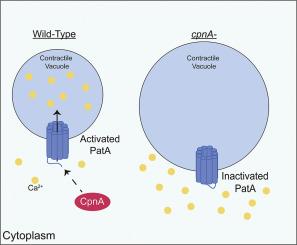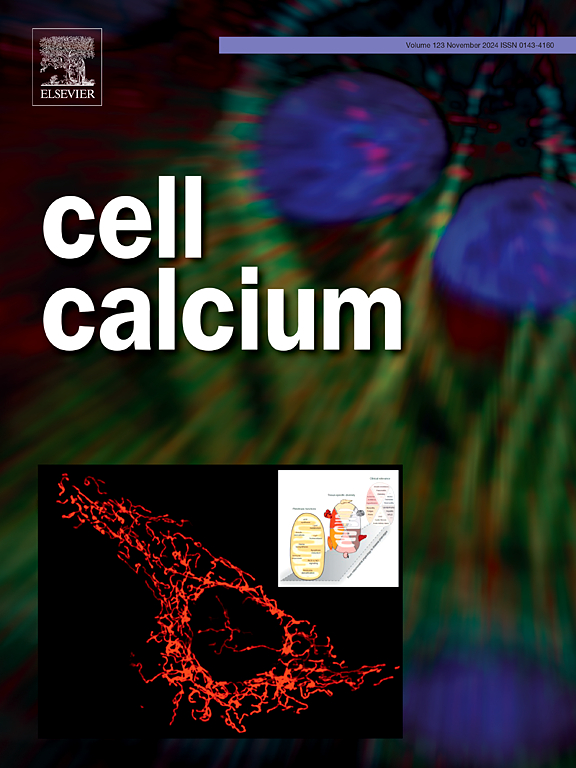Copine A is essential for calcium homeostasis in Dictyostelium
IF 4
2区 生物学
Q2 CELL BIOLOGY
引用次数: 0
Abstract
Copines are a family of calcium-dependent phospholipid-binding proteins found in most eukaryotic organisms. The expression of multiple copine genes is dysregulated in various types of human cancers. Yet, a common mechanistic function for copines remains enigmatic. We are studying copines in Dictyostelium, which has six copine genes (cpnA-cpnF). Cells lacking cpnA (cpnA-) exhibit many phenotypes including defects in development, chemotaxis, adhesion, and contractile vacuole (CV) function. In this study, we identified a novel link between CpnA and calcium homeostasis. We found that cpnA- cells have more phosphatidylserine (PS) exposed in the outer leaflet of the plasma membrane due to having an increased intracellular calcium concentration. The PS exposure defect and the enlarged CV defect in cpnA- cells were rescued by chelating calcium. We further investigated the role of PatA, a CV-localized Ca²⁺-ATPase responsible for pumping calcium into the CV. Although cpnA- cells expressed normal levels of patA, immunofluorescence revealed reduced PatA localization to the CV membrane. Notably, patA knockdown (patAKD) cells phenocopied cpnA- cells, displaying enlarged CVs, elevated intracellular calcium, and increased PS exposure. Taken together, our findings suggest that CpnA promotes calcium sequestration into the CV, likely by regulating PatA localization or activity. This role in calcium homeostasis provides a mechanistic framework for understanding copine function and offers insight into how calcium dysregulation associated with copines may contribute to cancer progression.

铜碱A对盘基骨菌的钙稳态至关重要
Copines是在大多数真核生物中发现的钙依赖性磷脂结合蛋白家族。多种copine基因的表达在各种类型的人类癌症中失调。然而,复制体的共同机制功能仍然是个谜。我们正在研究Dictyostelium中含有6个copine基因(cpnA-cpnF)的copine。缺乏cpnA (cpnA-)的细胞表现出多种表型,包括发育、趋化性、粘附和收缩液泡(CV)功能缺陷。在这项研究中,我们发现了CpnA和钙稳态之间的一种新的联系。我们发现由于胞内钙浓度的增加,cpnA-细胞有更多的磷脂酰丝氨酸(PS)暴露在质膜外小叶中。螯合钙修复了cpnA-细胞的PS暴露缺陷和CV增大缺陷。我们进一步研究了PatA的作用,PatA是一种位于CV的Ca 2 + - atp酶,负责将钙泵入CV。虽然cpnA-细胞表达正常水平的patA,但免疫荧光显示patA在CV膜上的定位减少。值得注意的是,patA敲低(patAKD)细胞表型化cpnA-细胞,表现为CVs增大、细胞内钙升高和PS暴露增加。综上所述,我们的研究结果表明,CpnA可能通过调节PatA的定位或活性来促进钙在CV中的固存。这种在钙稳态中的作用为理解copine的功能提供了一个机制框架,并为了解与copine相关的钙失调如何促进癌症进展提供了见解。
本文章由计算机程序翻译,如有差异,请以英文原文为准。
求助全文
约1分钟内获得全文
求助全文
来源期刊

Cell calcium
生物-细胞生物学
CiteScore
8.70
自引率
5.00%
发文量
115
审稿时长
35 days
期刊介绍:
Cell Calcium covers the field of calcium metabolism and signalling in living systems, from aspects including inorganic chemistry, physiology, molecular biology and pathology. Topic themes include:
Roles of calcium in regulating cellular events such as apoptosis, necrosis and organelle remodelling
Influence of calcium regulation in affecting health and disease outcomes
 求助内容:
求助内容: 应助结果提醒方式:
应助结果提醒方式:


